Heimkehle
Useful Information
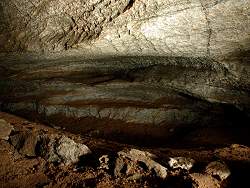
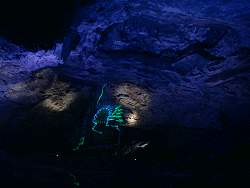
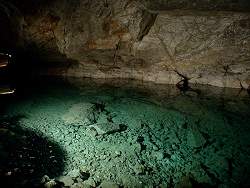
| Location: |
A7 exit Seesen (Harz), B243 66 km to Nordhausen, B80 16 km to Berga, turn left towards Stolberg (north), between Uftrungen and Rottleberode, 9 km south of Stolberg. Turn left on road 2 km to the cave. Signposted. (30,Lf40) |
| Open: |
MAY to OCT daily 10-17. NOV to APR daily 10-16. Tours as needed, normally every hour, at last 5 persons. [2003] |
| Fee: | |
| Classification: |
 Karst Cave Karst Cave
 gypsum cave, gypsum cave,
 World War II Bunker World War II Bunker
 Factory Factory
|
| Light: |
 LED LED
 Son et Lumière Son et Lumière
|
| Dimension: | L=2,000 m. GR: H=22 m, L=65 m, W=65 m. |
| Guided tours: | L=700 m, D=45 min, V=50,000/a [200?]. |
| Photography: | allowed |
| Accessibility: | yes |
| Bibliography: |
A.A. (k.J.):
Informationen Karstlandschaft Südharz und Die Heimkehle,
Karstmuseum Heimkehle.
Hrsg: Rat des Bezirkes Halle
( ) )
W. Remus, M. Spilker, R. Zeising (1962): Die Heimkehle bei Uftrungen am Südharz, Hrsg.: Gesellschaft zur Verbreitung wissenschaftlicher Kenntnisse, Bezirk Halle, Bezirkssektion Geowissenschaften, Arbeitsgruppe Sangerhausen, Höhlenverwaltung "Heimkehle", Uftrungen (  ) )
Reinhard Völker (1981): Die Heimkehle, Mitt. Karstmus. Heimkehle 1:1-40, Uftrungen (  ) )
Reinhard Völker (1985): Die Erschliessung der Heimkehle, Mitt. Karstmus. Heimkehle 10:1-15, Uftrungen (  ) )
|
| Address: | Höhlenverwaltung Heimkehle, Postfach 61, 06548 Uftrungen, Tel: +49-34653-305. |
| As far as we know this information was accurate when it was published (see years in brackets), but may have changed since then. Please check rates and details directly with the companies in question if you need more recent info. |
|
History
| 1357 | first mentioned. |
| 1649 | visited by the Prince of Anhalt. |
| 1920 | developed by Theodor Wienrich with electric light and paths. |
| 12-SEP-1920 | opened to the public. |
| 1944 | a factory for the production of aircraft parts installed in the cave by the Nazis. |
| 1946 | the entrances to the cave are blown by the allies. |
| 1953 | cave developed again, new entrances built. |
| 1954 | reopened to the public. |
| 1979 | Karstmuseum founded. |
Description
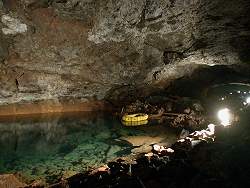
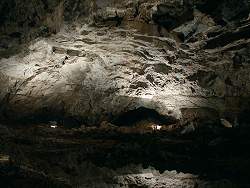
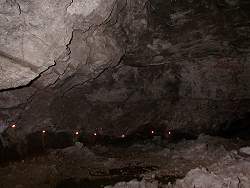
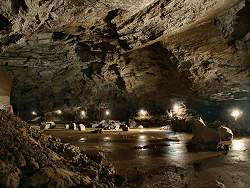
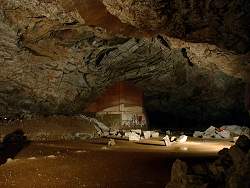
The Heimkehle is one of two big gypsum cave in Germany, which are open to the public. It is located at the southern rim of the Harz mountains, in a narrow area runnning from east to west, where gypsum is found at the surface. Because of the high solubility of the gypsum, this area is heavily karstified. The caves are especially very spacious, which is rare in Germany. This two caves are definitely the most impressive caves in Germany concerning size. Also the gypsum karst develops very fast and so it is rather rare. Thats why this caves are rather exceptional even on a European basis.
The Heimkehle is located around the groundwater table, and so many chambers contain water. Once the cave was visited by boat, as most of the halls were filled with huge interconnected lakes. Today the face of the cave has changed, primarily because of human encroachment. The cave is visited by foot and not by boat.
The main lake was covered with concrete in 1944, when the Nazis built an underground factory here. At this time the allied air raids on Germany were intensified and a part of the production was moved underground. The airplane parts which were produced here for the Junkerswerke in Dessau, were used to build JU88 planes. The cave was big enough for three factory units. Several tunnels connected the cave with the surface, the biggest one was huge enough for lorries. Beneath the size of the cave chambers, the softness of the rock was argument why this cave was used. So it was possible to build the necessary huge tunnels in a very short time.
After the war the Allied saw a military plant in this location and blew up all entrance tunnels. This caused additional destructions and the collapse of some side passages. Some time after the war, the status of the cave as a natural monument and a historic monument was recognized. So the cave was again developed as a show cave, by constructing new entrance and exit tunnels. Today the cave floor is covered by the debris of human destruction.
In the chamber called Kleiner Dom (Small Dome), a monument for the prisoners of the concentration camp KZ Mittelbau Dora near Nordhausen
(see
 Salzaspring)
is located.
Many of them were forced into slave labour here.
At the end of the war the remaining inmates were divided into three groups.
One group reached Schwerin, the second one got lost in the Harz mountains.
The third group reached Gardelegen, where more than 100 people were locked in a barn which was then burned down.
The monument for this history was created during the time of the German Democratic Republic.
This is the reason for its socialist aura, which is even a little ridiculous from today’s point of view.
But still this monument is very important and reminds people on a dark part of history.
It is laudable that it is still kept in order.
Salzaspring)
is located.
Many of them were forced into slave labour here.
At the end of the war the remaining inmates were divided into three groups.
One group reached Schwerin, the second one got lost in the Harz mountains.
The third group reached Gardelegen, where more than 100 people were locked in a barn which was then burned down.
The monument for this history was created during the time of the German Democratic Republic.
This is the reason for its socialist aura, which is even a little ridiculous from today’s point of view.
But still this monument is very important and reminds people on a dark part of history.
It is laudable that it is still kept in order.
The natural entrance is high above the cave floor, with a deep entrance hall. This is the typical form of a cold trap. The cold air from outside enters the cave and cools down the cave below zero, while the rocks are still warmer and dripping water from cracks still enters the cave. The result are icicles all over this part of the cave.
The Karstmuseum is located in the exit tunnel of the cave, and it is possible to visit it independently of a tour. The exhibition includes geology, speleology and mining of the copper slate. Most interesting are numerous cross-sections of caves, which explain the principles of karstification in gypsum.
The parking lot of the cave is also an important station of the karst trail. The 10 km long section Heimkehle-Pölsfeld shows and explains virtually all karst features of gypsum karst. A small brochure is available at the cave.
 Search DuckDuckGo for "Heimkehle"
Search DuckDuckGo for "Heimkehle" Google Earth Placemark
Google Earth Placemark Höhle Heimkehle, probably the most interesting page on this cave, part of the Karstwanderweg website. (
Höhle Heimkehle, probably the most interesting page on this cave, part of the Karstwanderweg website. ( Index
Index Topics
Topics Hierarchical
Hierarchical Countries
Countries Maps
Maps